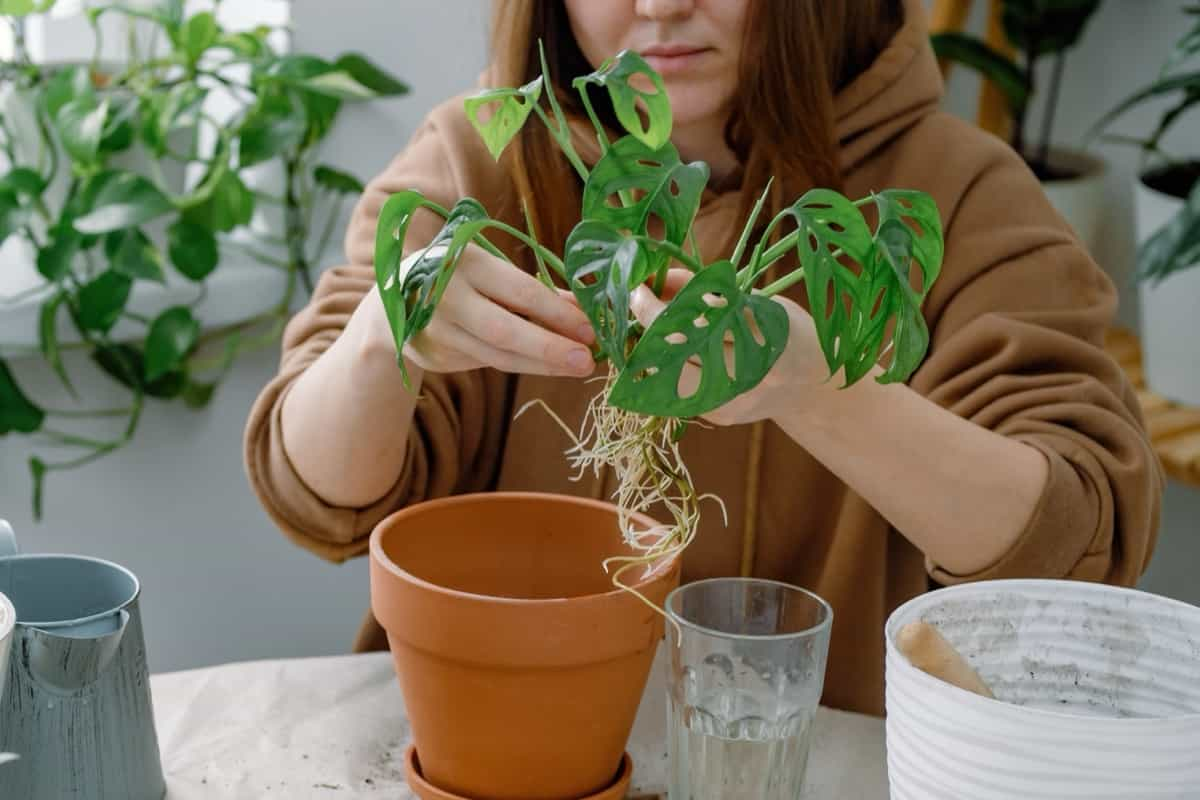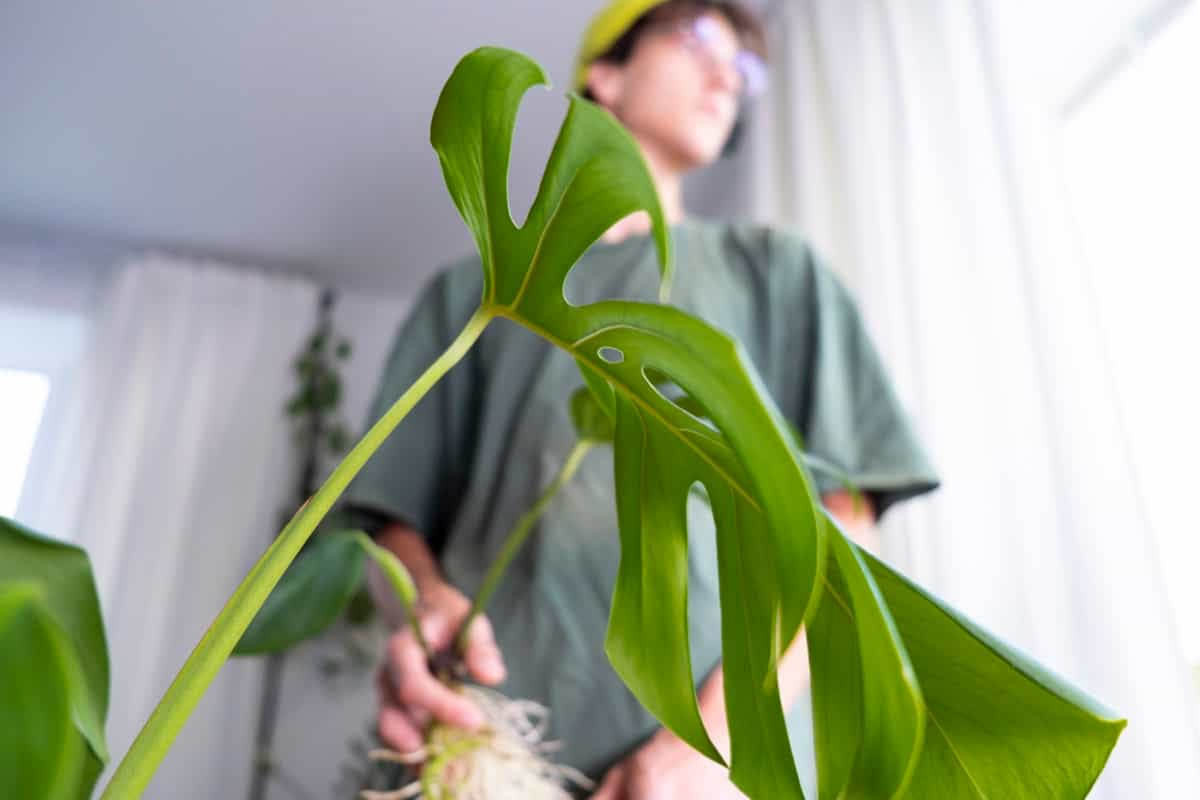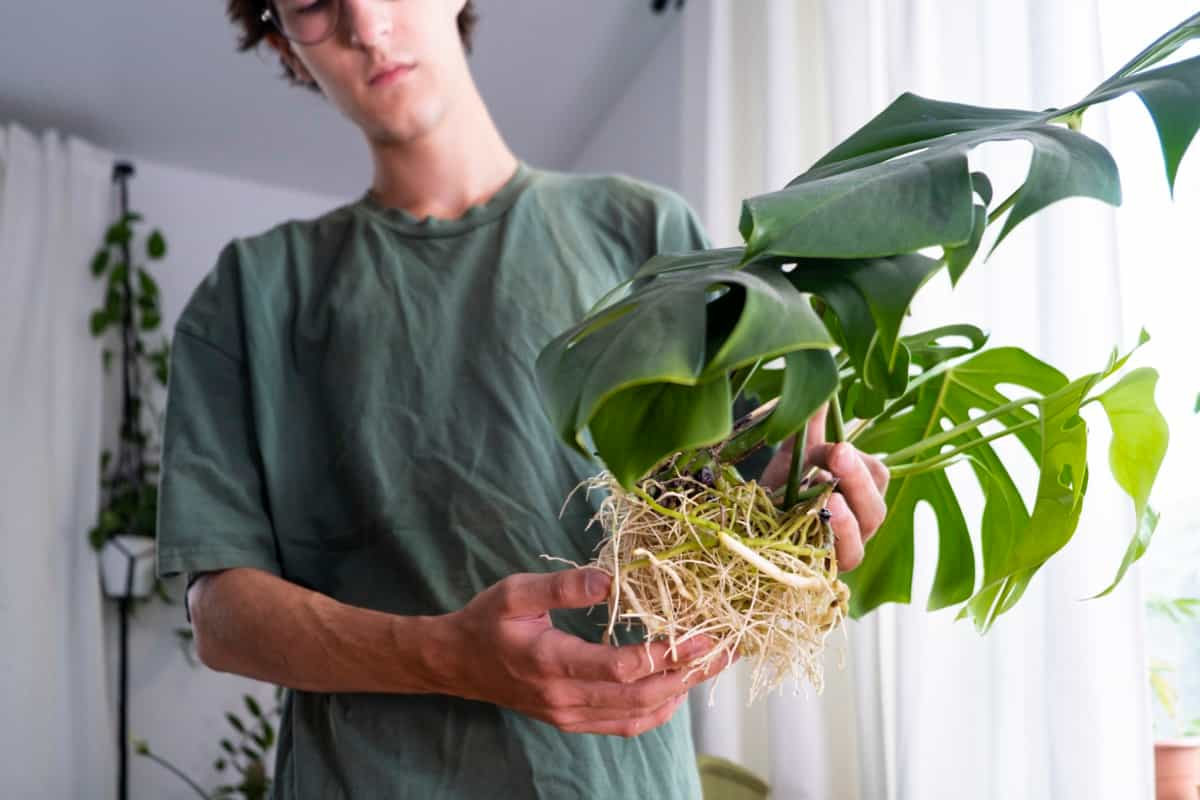Monstera propagation is an exciting way to grow new plants and expand your green family. When it comes to propagating Monstera, one of the key decisions you’ll need to make is whether to use water or soil for the process. Successful Monstera water propagation involves placing a Monstera cutting in a container filled with water until roots grow. This method allows you to monitor root growth closely and provides a visually appealing display as the roots sprout and elongate underwater.

On the other hand, soil propagation involves planting the cutting directly into a well-draining potting mix. This method mimics natural conditions more closely and can lead to faster overall growth. When deciding between water or soil propagation, consider factors such as your experience level, available resources, and desired outcome. Guide for water propagation of Monstera may be better suited for beginners seeking an engaging visual experience.
How to Propagate Monstera in Water
Selecting the Right Cutting for Water Propagation
When it comes to rooting Monstera plants in water, selecting the right cutting is essential for success. You should choose a healthy and mature stem that has at least one node. Look for a Monstera node cutting with several leaves on it, as this indicates that the plant is well-established and can handle being propagated. Avoid using cuttings with yellow or damaged leaves, as these may not have enough energy to produce roots.
It’s also important to consider the length of the cutting. Aim for a stem that is at least 6-8 inches long, as shorter cuttings may not have enough stored nutrients to support root development. When taking your cutting, use clean and sharp pruning shears to make a clean cut. This will promote new growth and encourage root formation.
Preparing the Water for Monstera Propagation
Preparing the water for Monstera propagation is a crucial step in ensuring successful root development. First, you’ll want to use filtered or distilled water to avoid any harmful chemicals that can hinder growth. Chlorinated tap water may not be ideal for your cuttings. Next, select a clean container free from any residue or contaminants. A glass jar or vase works well, as it allows you to monitor root growth easily. Fill the container with about 2-3 inches of water – enough to submerge the bottom nodes of your Monstera cutting.
To give your cuttings an extra boost, you can add some rooting hormone to the water. However, it’s important to follow the instructions on the rooting hormone package and not exceed recommended doses. Change out the water every 7-10 days to prevent stagnation and keep it fresh for optimal oxygen levels. When changing the water, gently rinse off any algae or debris that may have accumulated on your cutting or in the container.
Placing the Monstera Cutting in Water: Best Practices
Placing the Monstera cutting in water is a crucial step in propagating this beautiful plant. To ensure successful root development, there are a few best practices to follow. Choose a glass or jar that is tall enough to accommodate the length of your cutting. The container should have a wide opening to allow for easy insertion of the cutting. Next, fill the container with water at room temperature. It’s important not to use chlorinated tap water as it can hinder root growth. Instead, opt for filtered or distilled water.
In case you missed it: How to Propagate Philodendron: With Water, Soil, Air, and Division

Before placing the cutting in water, make sure to trim any leaves that would be submerged. Gently insert the cut end of the stem into the water, making sure it is fully submerged but without any leaves touching the liquid surface. You may need to use small weights or clips to hold larger cuttings upright if they tend to float. Find a suitable location for your container where it can receive bright, indirect light.
Monitoring Root Growth During Water Propagation
One of the most exciting aspects of propagating Monstera in water is watching the roots develop and grow. Patience is key. While some cuttings may sprout roots within weeks, others may take several months to show any signs of growth. To monitor root growth, regularly inspect your Monstera cuttings by gently lifting them out of the water. Look for small white or light-colored nodules emerging from the stem nodes. These are early indicators that roots are forming.
Another way to gauge root development is by observing changes in leaf appearance. As roots begin to grow, you may notice an increase in leaf size or new leaves unfurling. This indicates that the cutting has established a strong enough root system to support foliage growth. Remember to keep an eye on water quality as well. If it becomes murky or foul-smelling, it could indicate bacterial or fungal issues, which can hinder root development.
Transferring Monstera Cuttings from Water to Soil
First, prepare a well-draining potting mix for your Monstera. You can create equal parts of perlite, peat moss, and regular potting soil. Next, gently remove the Monstera cutting from the water, being careful not to damage its delicate roots. Give it a quick rinse with clean water to remove any remaining residue or algae. In the prepared soil mixture, dig a small hole and place the cutting into it.
Make sure that at least an inch or two of its roots are buried thoroughly after planting around the roots and provide hydration for your new plant. Place your potted Monstera in a location with bright indirect light and maintain consistent watering as needed. It’s important to monitor your newly transferred Monstera closely during this period of adjustment. Keep an eye out for any signs of stress or wilting, which may indicate that additional care is required.
Troubleshooting Common Issues in Water Propagation
Stagnant Water: One common issue you may encounter during water propagation is stagnant water. If the water becomes cloudy or develops a foul odor, it could indicate bacterial growth. To remedy this, replace the water every few days and ensure that your container has good airflow.
Root Rot: Another issue with Monstera water propagation is root rot, which happens when the roots are constantly submerged in water without enough oxygen. To prevent this, make sure there are air holes in your container and avoid overwatering.
In case you missed it: How to Propagate Calathea Plant: Ways to Grow from Water, Soil, Division, and Cuttings

Lack of Root Growth: If you notice that your Monstera cutting isn’t developing roots after several weeks, it may be due to low humidity or insufficient light. Consider misting the leaves regularly or using a humidity dome to create a more suitable environment for root development.
Mold or Fungus: Mold or fungus growth on the cutting can hinder root growth and impact overall plant health. Ensure proper ventilation and cleanliness by periodically wiping down the container with diluted hydrogen peroxide or vinegar solution.
Pale Leaves: Pale leaves on your Monstera cutting could indicate inadequate nutrients in the water or lack of sunlight exposure. You might want to consider adding a diluted liquid fertilizer to promote healthy leaf coloration.
Tips for Successful Monstera Water Propagation
- Choose healthy cuttings: When selecting cuttings for water propagation of Monstera, make sure they come from a healthy and mature Monstera plant. Look for leaves that are free from damage or disease.
- Use filtered or distilled water: It’s best to use filtered or distilled water to provide optimal conditions for your Monstera cutting.
- Place the cutting in indirect light: While Monsteras love bright, indirect light, it’s important not to expose the cuttings to direct sunlight during the rooting process. Too much sun can cause stress and inhibit root growth.
- Change the water regularly: To prevent bacterial growth and ensure oxygen availability, change the water every 7-10 days.
- Maintain consistent temperature and humidity: Monsteras thrive in warm and humid environments, so aim to keep the temperature around 21-24°C with humidity levels of 60% or higher.
- Be patient: Rooting in water can take several weeks or even months, so be patient throughout the process. Check on your cutting regularly, but avoid disturbing it too often, as this can disrupt root formation.
- Consider using rooting hormone: If you want to speed up the rooting process, you can dip your Monstera cutting in a rooting hormone before placing it in water. This may increase success rates and encourage quicker root development.
Comparing Water Propagation to Other Methods
When propagating Monstera plants, there are a few different methods you can try. While water propagation is popular among plant enthusiasts, it’s important to understand how it compares to other methods. One commonly used method for propagating Monstera is soil propagation. This involves placing the cutting directly into a pot filled with moist soil and waiting for the roots to develop. Soil propagation can be effective, but it requires more patience and careful monitoring of moisture levels.
Another option is using sphagnum moss for propagation. With this method, you wrap the cutting in damp moss and secure it with a plastic bag or container. The moss helps retain moisture while allowing air circulation around the cutting. Compared to these methods, water propagation has its advantages. For one, it allows you to monitor root growth easily since the roots are visible in the water. Additionally, water provides constant hydration without risking overwatering or underwatering.
However, there are also some downsides to consider when choosing water propagation. One potential issue is that prolonged exposure to water can make roots weaker compared to those grown in soil or moss. Additionally, transferring cuttings from water to soil may require extra care and attention. Some people find success with one method, while others prefer another based on their experience and environment.
Frequently Asked Questions (FAQ) on Monstera water propagation
Can I Propagate My Monstera in Water if it Has Aerial Roots?
Yes, absolutely! Monstera cuttings with aerial roots tend to root faster in water compared to those without. Place the cutting with the aerial root into a jar of water and watch as it develops new roots.
In case you missed it: How to Propagate Elderberries from Cuttings: A Step-by-Step Process Guide

Do I Need to Change the Water During Propagation?
It’s recommended to change the water every week or two to prevent any potential buildup of bacteria or algae that could hinder root development. Be sure to use room temperature or lukewarm water when changing it.
Should I Use Any Additives or Rooting Hormones in the Water?
While not necessary, some people choose to add a small amount of liquid fertilizer or rooting hormone diluted in their propagation jar. This can provide extra nutrients and stimulate root growth.
Conclusion
Monstera plants are popular houseplants that have gained widespread popularity in recent years. With their large and unique leaves featuring distinctive holes, they add a touch of tropical beauty to any indoor space. The method for propagating Monstera in water is a rewarding and fascinating process that allows you to grow new plants from cuttings.
Monstera propagation timeline in water depends on several factors. This method offers several advantages, such as being able to monitor root growth closely and ensuring the cutting gets the right amount of moisture.
- How to Grow Tomatoes Organically at Home: A Comprehensive Guide
- Organic Gardening on a Budget: Low-Cost Methods and Materials
- Gongura Seed Germination and Planting Methods
- Cabbage Seed Germination and Selection
- Broccoli Seed Germination and Selection
- Asparagus Seed Germination and Variety Selection
- Seasonal Flower Gardening: Best Practices for Spring, Summer, Fall, and Winter
- How to Grow Hibiscus from Flower
- Plantation Ideas for Home Decoration: A Beginners Guide